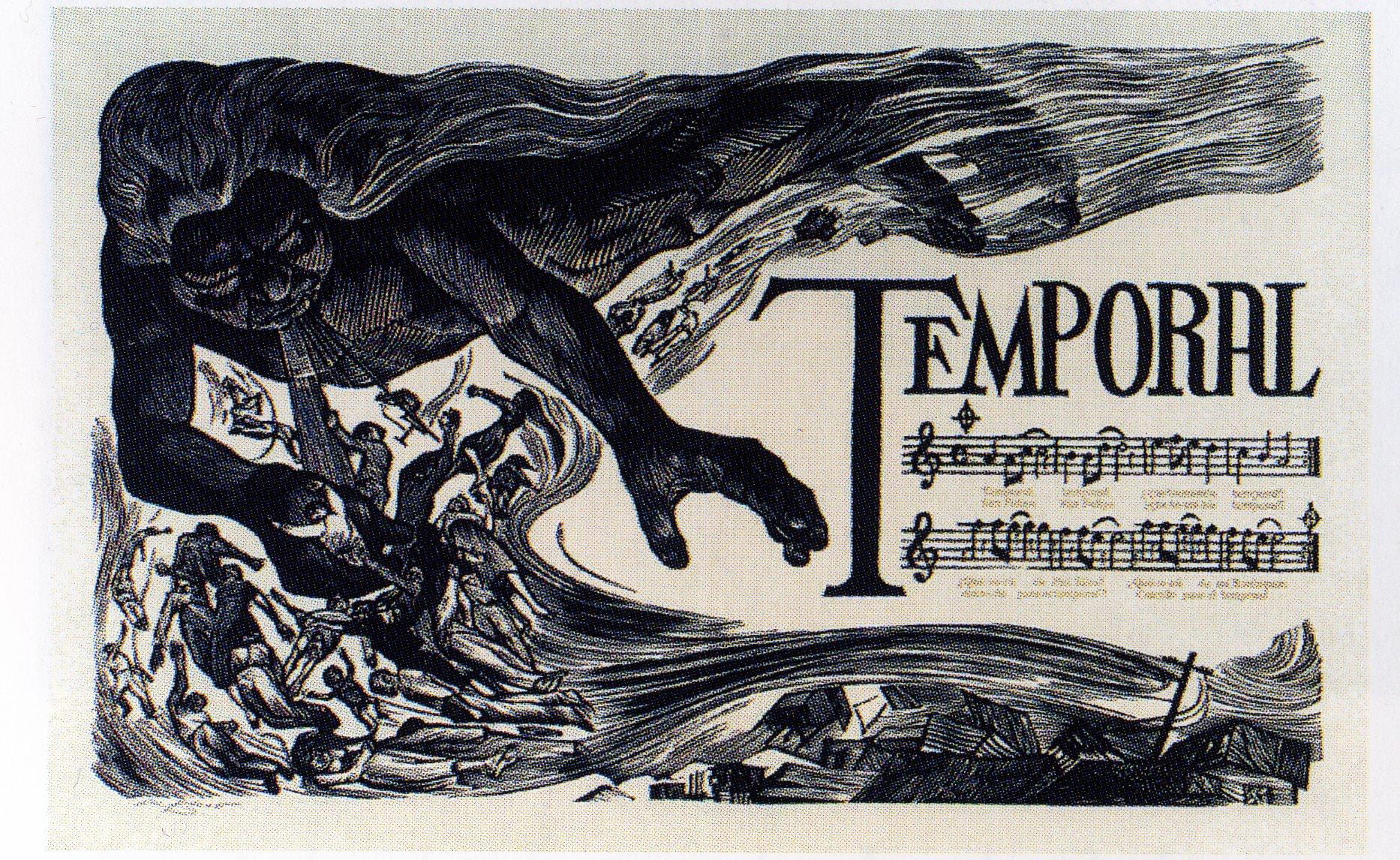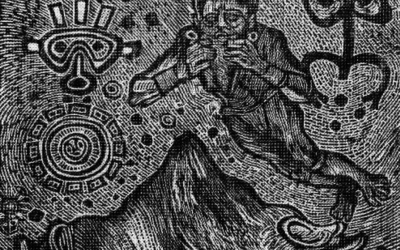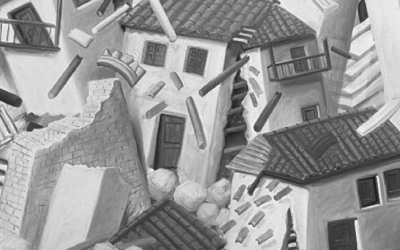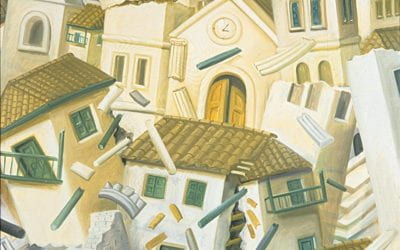Differential Disasters
The 1928 Hurricane and the Shaping of the Circum-Caribbean Region

This engraving temporal (1953-55) was made especially by Puerto Rican artist Rafael Tufiño to commemorate the 1928 storm. Tufiño engraving photographed by Amir Señeriz Longo courtesy of Prinardi Art Gallery.
Temporal, temporal, allá viene el temporal.
¿Que será de mi Borinken, cuando llegue el temporal?
(Hurricane, hurricane, here comes the storm)
(What will become of my Puerto Rico when the hurricane arrives?)
Every Puerto Rican knows this plena and can sing its chorus, and on that island where from July to October everyone frequently checks the weather reports and looks to the sky, the song seems to describe a generic situation, a way of life, and a common reality. Few people today remember that the song was originally composed to commemorate a particular storm: the great hurricane of San Felipe that traversed Puerto Rico on September 13, 1928.
Hurricanes are no novelty to the islanders, but the fury of that one was memorable. No one who lived through the howling winds and the terror of a sky filled with the flying zinc roofs of the demolished houses forgot it. Winds reached 150 miles per hour, the strongest ever recorded on the island. Property damage was in the millions, and more than 300 people officially (but perhaps as many as 1,500 in reality) lost their lives as a direct result of the storm, the number, in fact, kept relatively low because of the lessons learned and precautions taken after the hurricane of 1899 (San Ciriaco) that had killed more than 3,000 islanders. In the 1928 storm, the island’s coffee crop was almost lost in its entirety, and thereafter Puerto Rico never regained its position as a coffee exporter. The island had been devastated. But the great storm was not done. It had already run its deadly course, respecting no cultural or political frontiers. Hurricanes never do. Before it crossed Puerto Rico, the storm had battered the British West Indian island of Dominica and French-speaking Guadeloupe and then had followed a northwest track ripping into the Virgin Islands and leaving devastation and death in its wake. Now, after traversing Puerto Rico, it headed northward passing over the Bahamas, and then slammed into West Palm Beach on September 16, 1928. Then it moved west and north, skirting the glades and passing over Lake Okeechobee, where thousands of Bahamian migrant laborers brought in to work the new fields perished in the rising waters and bursting dikes. It then turned northward to New England. The impact of the storm, and even what kind of “natural disaster” it was, had differed according to the social and political arrangements that had preexisted it and those that followed it. The storm brought, or had created, challenges and opportunities, but these had varied along its path.
Empires, nations, and people in the Circum-Caribbean have created historical realities and cultural differences that have served as the basic markers for understanding and interpreting the region. However, the San Felipe storm, like others of its type, demonstrated an underlying environmental unity that also provides a central thread or means to understand a Caribbean region too often viewed in terms of its insularity and cultural differences. The storms marked the importance of region in a historiography of places. As much as slavery, race, immigration, or imperialism, the hurricanes have defined the region. The same storm produces a differential impact on the societies that it crosses, and within those societies, its effects are suffered differentially by different groups and interests. Recently, Hurricane Katrina has made that all too clear. It is by looking both comparatively across imperial and national frontiers and internally across social and ethnic boundaries that the impact of the hurricanes is best understood. The 1928 San Felipe hurricane can serve as an example of the commonly shared threat of natural disaster and the differential effects caused by the social, cultural, economic, and political contexts of the storms.
HURRICANES IN HISTORY
Hurricanes present a variety of opportunities for historians. They are natural phenomena, but they are not necessarily natural disasters for only when a storm encounters dense concentrations of people or property does it become a catastrophe. The location of populations, the development of beach front homes and hotels, the failure to impose proper building codes: all have contributed to increasing the destructiveness of the Caribbean storms. We confront a seeming anomaly. Despite technological and scientific advances in prediction, the destructive effects of natural disasters have increased considerably since 1960. The average annual mortality due to disasters increased from 23,000 per year to 143,000 between the 1960s and 1970s, but property damage has increased even more. But property values aside, the Southeast Asian Tsunami of 2004 and the New Orleans hurricane of 2005 underline the fact that in human terms, by far the worst sufferers of the effects of “climatic” disasters have been poor people and poor countries. In the contemporary world, “natural disasters” like hurricanes have been socially selective, and they have probably been so in the past.
Historians of the hurricanes need to ask how natural disasters shape politics and social relations, and how political and social structures create the contexts for the impact of those phenomena. How did explanations for and understandings of the storms reflect changing conceptualizations of God, Nature, Science, and human abilities? Then too, there is yet another level of analysis that awaits attention. What has been the long-term cumulative effect of repeated natural disasters on the region? To what extent have the storms contributed to the regional problems of growth or development? Such issues have never been calculated or estimated the way in which economist Eric Jones sought to do in his attempt to explain Europe’s economic advantage over Asia by making comparative environmental conditions and their cumulative effects part of a larger economic history of regional development. The Caribbean might lend itself particularly well to such an analysis although information is spotty and the formula for calculation will be extremely complex.
The writing of the history of hurricanes like that of much environmental history begins with a problem. For all their power and destructive potential, the history of the hurricanes is, because of their frequency, almost inherently boring. Unlike volcanoes or earthquakes, the great storms are somewhat dependable. Almost every year some island or coast is inundated or devastated. While for individual islands or cities or stretches of shoreline, hurricanes may be spaced decades apart, in a regional sense, the phenomenon is repetitious and the results expected.
The scenes of destruction are all too common and all too similar: shattered homes and shattered lives, boats piled up on the beaches or carried far inland, destruction in all directions, and later on, scenes of relief and aid amidst a backdrop of ruin. The individual stories may be poignant, but their repetition is numbing. Accounts seem to vary only in the level of destruction, the amount of loss, or the level of the force of the winds. If the story to be told is only that of the storms themselves, then the repetitiveness is inherent. The variations from one storm to the next may be interesting from a meteorological perspective, but have less significance from a historical one.
Moreover, as acts of nature or the handiwork of God, the hurricanes are beyond human control and are therefore outside of history, which explains why they have been ignored as a theme in themselves. Storms are the classic deus ex machina that we as historians and social scientists are admonished to avoid like the plague. But, at the same time, because of their ubiquity and regularity, we can also fall into the opposite error of seeing them as the explanation of everything. Almost every event, battle, revolt, revolution or election in the Caribbean region has been preceded by one or several hurricanes. To find the balance between explaining too much and too little in the history of the hurricanes is a tricky business at best.
From the time of Columbus, hurricanes shaped the patterns of settlement in the Caribbean and the structures of maritime commerce. Their effects challenged governments to respond, and those that failed revealed their weakness and lost their legitimacy. Revolts and upheavals have sometimes followed the storms. The storms determined or contributed to the outcome of individual military engagements and imperial struggles as well as the competition for markets. The hurricanes caused populations to rethink the role of God and Nature in human affairs and to seek in the technology of communications and prediction ways to answer the threat. And above all, the hurricanes and their effects have served as prisms through which societies can be seen.
THE CONTEXTS OF DISASTER: THE 1928 HURRICANE
The 1928 San Felipe or Okeechobee hurricane is a particularly interesting example because the storm’s differential impact in Florida and Puerto Rico allows us to see the ways in which local conditions contextualized the same natural threat. Leadership in both societies had a vision of an ideal future and were willing to use the disaster as a tool to implement that vision. By 1928, the American National Red Cross was functioning, and its reports and efforts in both Florida and Puerto Rico provided considerable information on the impact and nature of reconstruction.
In Puerto Rico, immediate mortality was relatively low, but the San Felipe storm left about a third of the population of 1.5 million homeless. Most of the $40 million in property loss had been to privately-owned properties. There were those in the political class of the island who saw recovery as an opportunity to restructure society by creating a countryside populated with industrious small farmers living in neat cottages, the realization of the old rural myth of the hardy jíbaro. Natalio Bayonet Díaz, ex-member of the House of Representatives, urged the governor to call on Puerto Ricans to shoulder the burden of recovery and not depend on foreign aid. He warned that rural-to-urban migration had to be prevented at all costs, and that only children and women either tending families or unable to work should be able to receive free food. Over 40,000 homes had to be rebuilt to house about 250,000 rural people left homeless by the storm, but that task also offered reform opportunities. Bayonet Díaz argued that building new, orderly residences would be a necessary improvement, “solving once and for all the problem of hygienic dwelling for our laboring men, and causing to disappear from the countryside the wretched sight of the hut (bohío) which is a stigma upon our civilization.” But one could not give the poor and destitute something for nothing. The rebuilding was to be done under the supervision of the relief agencies and municipal committees by the country people themselves, who were paid for their labor, 10 percent in cash and 90 percent in food rations.
This kind of social engineering also emerged in a plan for relief developed by the sugar growers and supported by Guillermo Esteves, the Commissioner for Puerto Rico. The plan divided the affected population into three categories; small owners, the urban working poor, and the arrimados, those working on the big coffee estates who themselves could be divided into two groups, those who lived by cultivating a small plot and those who lived in small barracks as employees without any land. Esteves sought to convince the Red Cross that social divisions or categories within the population had to be treated differently and that “the good qualities of the Puerto Rican small farmer recognized by all” should be stimulated. The small proprietors were of “good moral character” and could be trusted to rebuild and improve their land and did not need to be supervised. In contrast, other groups had to be treated more cautiously. Above all, he opposed moving arrimados from the coffee farms to small towns. Instead, he advocated the building of houses and the distribution of small plots to the workers, but only after the haciendas had recovered and work was available. If work were rushed, the Red Cross would be forced to bear the burden. Esteves claimed “these arrimados love the land they till and they are the seed from which future farmers will sprout.” But his admiration had limitations. Since the resources of the landowners had to be used in replanting their lands, funds should be given to the landowners who could provide the rural laborers with shelter and work. It was a plan that responded to the specificities of the island’s society, but that once again placed authority and resources in the hands of the predominant planter class since only they could provide for the islands’ future.
In Florida too there was a desire to rebuild for the future. The power of the storm had not been shared equally. Bahamian and other West Indian workers at Belle Glade and other small communities near Lake Okeechobee had borne the brunt of the storm. In the racially differentiated world of 1920s Florida it was to be expected that in the effort to relieve and rebuild, differences of color played a role as well. Attention went to property losses in Delray and Palm Beach, not to the unnamed bodies swept away by the waters or burned in communal pyres. The Red Cross, in fact, created a Colored Advisory Committee that had among its tasks the refutation of “rumors” about aid not being apportioned equally among blacks and whites. There were problems. The poor had lost homes that were heavily mortgaged and faced foreclosure. If the Red Cross reconstructed them, it argued, the lenders rather than the homeless would profit. So, such homes were not rebuilt. There were complaints. The Red Cross became defensive in the face of Black criticism. In its final report, it argued: “The Committee, knowing that its people are receiving their full pro-rata of relief, cannot but be embarrassed when ungrounded complaints are aired by chronic kickers.”
Such unpleasantness did not stop progress. South Florida was committed to ordered growth and agricultural and urban development. The storm would not be allowed to undermine its trajectory. In March 1929, before the Director of the Red Cross left Florida, the West Palm Beach Chamber of Commerce arranged for him to fly over the area. From the air he saw, as the Red Cross reported “Cities, towns and villages had been set in order; cleared streets were lined with replanted parkings; agricultural lands were drained and covered with a most luxuriant growth of vegetation that seemed to have sprung up almost overnight; fields were again separated by ribbon-like drainage and irrigation canals; the whole countryside was dotted with reconstructed homes, the new unpainted lumber glittering brightly in the morning sun.” The storm had not been allowed to alter the road to progress.
In both Puerto Rico and Florida, the storm had been a disaster, made so by actions and decisions that long preceded the arrival of the winds. In both places, responses took place within a social and ideological context that patterned them. What we witnessed with the response to Katrina is really part of an old and continuing story that can provide a pathway to understanding the history of the whole Caribbean region and a prism through which societies can view themselves.
Winter 2007, Volume VI, Number 2
Stuart B. Schwartz is the George Burton Adams Professor of History at Yale University. A longer version of this essay was presented as the keynote address at “Winds of Change: Environmental, Political, Social, and Cultural Forces in the Shaping of the Atlantic World,” the Third Biennial Allen Morris Conference on the History of Florida and the Atlantic World (Tallahassee, February, 2004). That was published as “Hurricanes and the Shaping of Caribbean Societies,” Florida Historical Quarterly, 83:4 (2005), 381-409.
Related Articles
Editor’s Letter: Natural Disasters
We were little black cats with white whiskers and long tails. One musical number from my one and only dance performance—in the fifth grade—has always stuck in my head. It was called “Hernando’s Hideaway,” a rhythm I was told was a tango from a faraway place called Argentina.
After the Earthquake: Juan’s Life
Juan was a construction helper. He lived in Armenia, but his parents were from the Antioquia region, who had fled because of the violence there. The mother of his children was called…
Political Memory
Late in 1717 Dr. Joseph Surin, precentor of the Cathedral of Old Guatemala, carried out some calculations: had the mudslide that wiped the city on the 28th of August, feast day of Saint…




